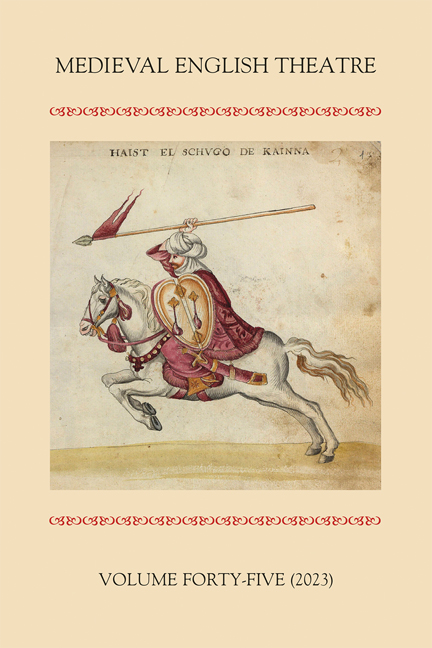Book contents
- Frontmatter
- Contents
- Illustrations
- Notes on Cover Image and Online Links
- Common Abbreviations
- Editorial
- John Blanke’s Hat and its Contexts, Part 1: Turbans and Islamic Dress at the Court of Henry VIII
- Disjointed Unison: Bodily Porousness and Subversion in the Croxton Play of the Sacrament
- The Disabled Body as Performance: ‘Disabled’ Performers in the Records of Early English Drama
- From Huy to Primrose Hill: An Early Twentieth-Century English Re-Playing of a Fifteenth-Century Liégeois Nativity Play
- ‘More medieval morality play than 21st century’: Spectacle and its Meaning at the Coronation of King Charles III
- The Seven Sages of Scotland: The Scottish Storytelling Centre, Edinburgh, Saturday 22 July 2023
- Editorial Board
- Submission of Articles
The Disabled Body as Performance: ‘Disabled’ Performers in the Records of Early English Drama
Published online by Cambridge University Press: 08 May 2024
- Frontmatter
- Contents
- Illustrations
- Notes on Cover Image and Online Links
- Common Abbreviations
- Editorial
- John Blanke’s Hat and its Contexts, Part 1: Turbans and Islamic Dress at the Court of Henry VIII
- Disjointed Unison: Bodily Porousness and Subversion in the Croxton Play of the Sacrament
- The Disabled Body as Performance: ‘Disabled’ Performers in the Records of Early English Drama
- From Huy to Primrose Hill: An Early Twentieth-Century English Re-Playing of a Fifteenth-Century Liégeois Nativity Play
- ‘More medieval morality play than 21st century’: Spectacle and its Meaning at the Coronation of King Charles III
- The Seven Sages of Scotland: The Scottish Storytelling Centre, Edinburgh, Saturday 22 July 2023
- Editorial Board
- Submission of Articles
Summary
The study of historic disability has enjoyed increasing interest among scholars working across the arts and humanities. The role of disability on the early modern stage has drawn particular critical attention, as scholars look to shed further light on some of those ‘thousand natural shocks’ to which Hamlet says all flesh is heir. Richard III's deformity, Gloucester's blindness, Lear's madness, the ubiquitous bodily mutilation in revenge tragedies such as Titus Andronicus, for example – many of these iconic staged ‘impairments’ have featured in recent studies of historic disability. This chapter takes a different tack. Drawing on the substantial evidence offered by the Records of Early English Drama (REED) project, which identifies record references to pre-modern performances across Britain, it ultimately looks at some of the evidence for actual performance by those with physical disabilities, in order to begin to place these examples alongside the well-known fictional representations. Attempting to draw together some of the different kinds of evidence for disability and premodern performance raises a couple of key questions: beyond the much studied literary and artistic examples, what might the evidence offered by REED have to say about the physically disabled body as it played a part in premodern performance? And can records for performers with apparent physical disabilities tell us anything about how they might have been conceptualised, characterised and/or accommodated in premodern British society? This chapter hopes to initiate potential responses to such questions.
Derived from a wider study of the performance of disability in the early British and Irish record,3 this chapter highlights the surviving record evidence in order to reframe how such performers contributed to wider premodern performance culture. The latter part of the chapter presents the evidence that relates specifically to musculoskeletal difference in the Records of Early English Drama. It suggests that the published and forthcoming REED collections can tell us a good deal about those performers whose physical impairment and/or difference affected their conceptualisation as performers. I do not include the references to so-called dwarfs or giants, as focus here is trained solely on performers identified as differently shaped rather than differently sized.
- Type
- Chapter
- Information
- Medieval English Theatre , pp. 102 - 125Publisher: Boydell & BrewerPrint publication year: 2024



